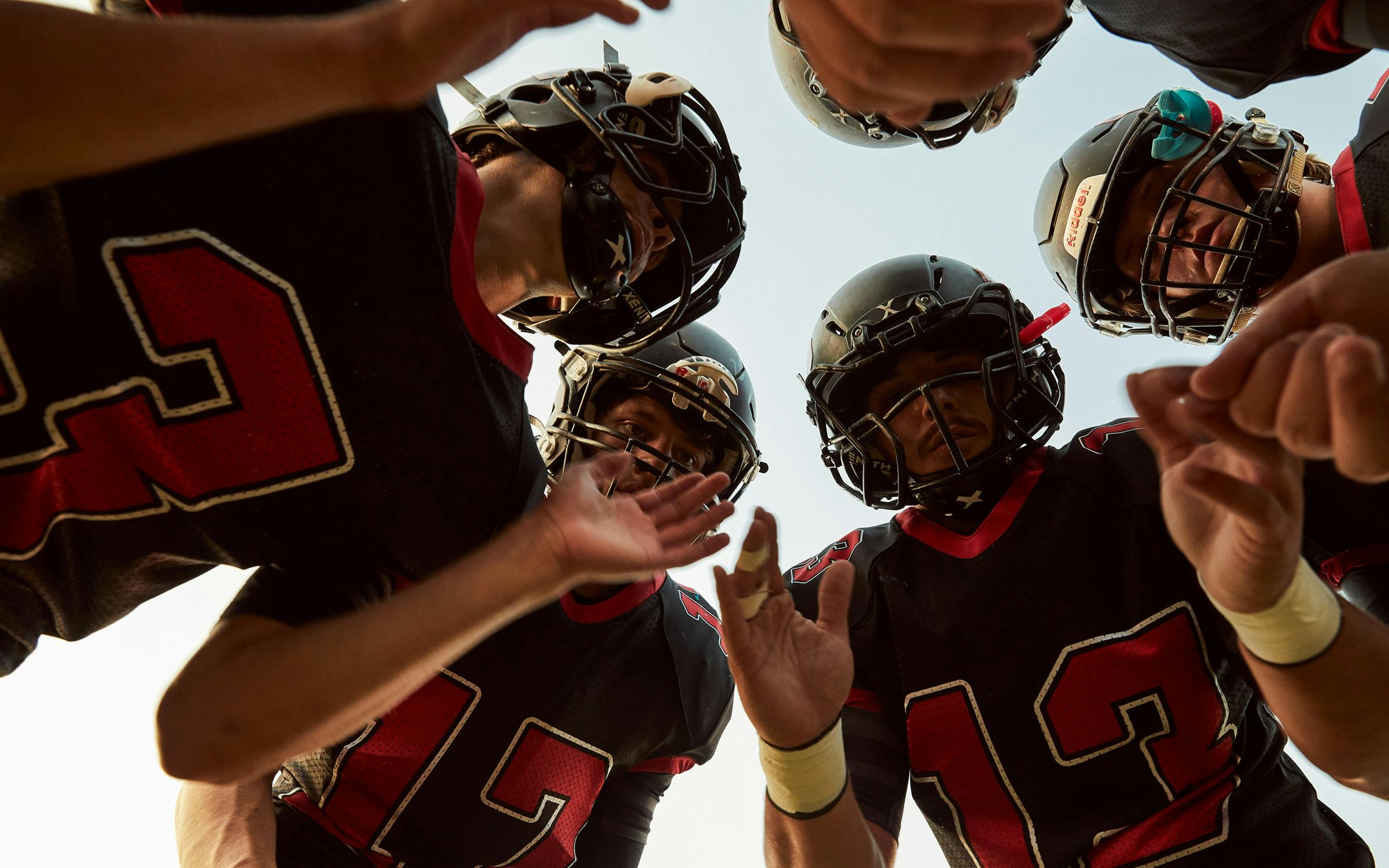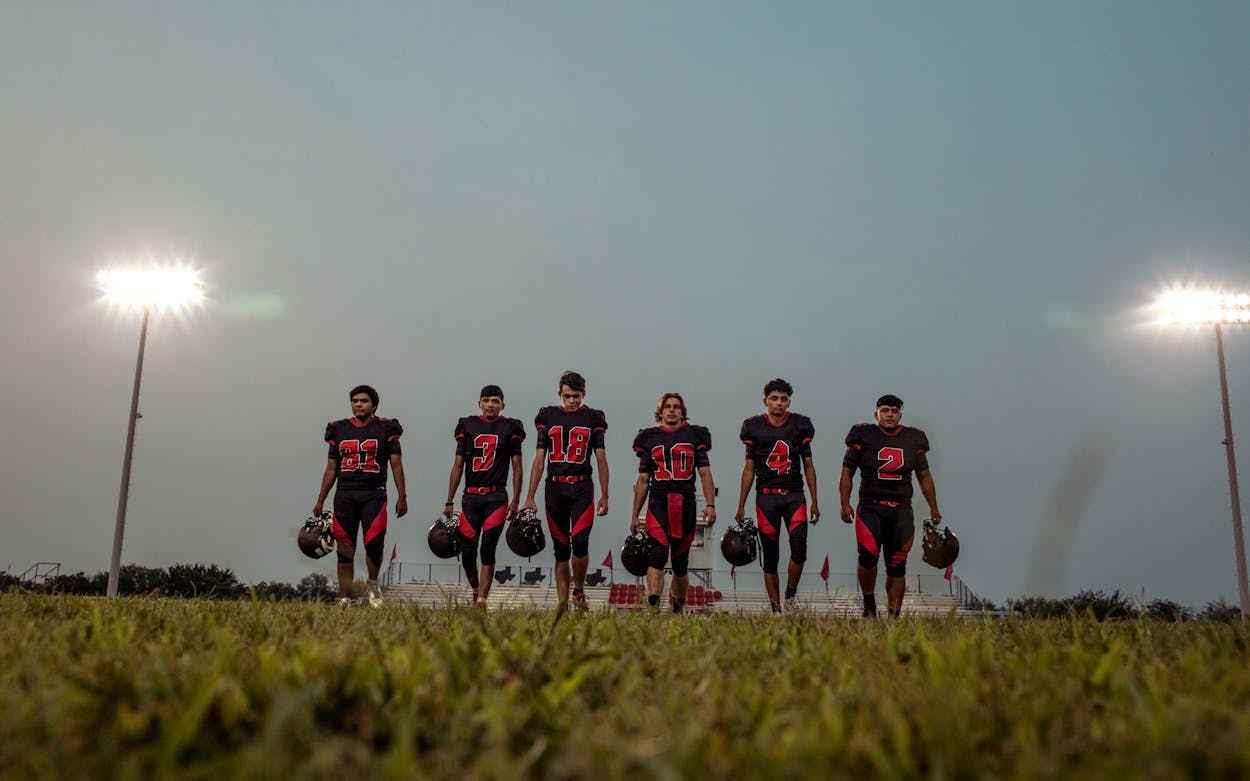About halfway through the second episode of Texas 6, scrawny quarterback Blaze Duncan cooks fajitas with orange juice. The OJ, he explains, makes the beef more tender, giving the aspiring chef’s signature “Bleetas” (Blaze plus fajitas) their savory flavor. The CBS All Access docuseries, which debuted in late November, is shot through with these small, telling moments—the looks of affection between Blaze and his grandma; the coach and his star player bonding over a Public Enemy song; the way a player describes his job at a pet mortuary—that resonate more deeply than any game highlight.
Although the series ostensibly focuses on tiny Strawn High School’s six-man football team, the show excels by depicting its characters’ interior lives and the idiosyncrasies they reveal when the helmets are off. Texas 6, whose eight-episode season one will conclude on December 31, was recently renewed for a second run, and viewers will find that the show touches on the small-town dreams and fleeting teenage glory audiences have come to expect from the subgenre birthed by Friday Night Lights. But Texas 6 excels most in its deft portrayal of the aspirations, heartbreaks, monotony, and minutiae of life in rural Texas. For that, much of the credit belongs to director Jared Christopher, who previously helmed Titletown, TX, another football docuseries that followed a different high school or college program in each of its three seasons.
Texas 6 turns its attention to small-town Strawn, a speck on the map midway between Abilene and Fort Worth with a population of 676 residents. In Texas, any school with an enrollment under 105 students competes in UIL’s 1A conference, making Strawn (class of 2020: sixteen students) a small town even by small-town standards. Its high school football team has won four state championships in the last twenty years, and when Texas 6 joins them at the beginning of the 2019 season, the Greyhounds are angling for a rare three-peat. If you’ve heard of Strawn, you’re either a six-man football fanatic or an acolyte of chicken-fried steak—a specialty at Mary’s, the town’s sole restaurant. Strawn has no stoplight, and when the show begins, the town has only recently put up a few stop signs.

From its opening frames, Texas 6 makes it clear that this ranching community has seen better days, and even its current football glory betrays the town’s decline. In the first half of the twentieth century, the team played traditional eleven-man football. As Strawn’s population shrank, the team adopted a six-man variant on the sport played on an eighty-yard field where every offensive player is an eligible receiver. It’s not uncommon to see multiple backfield laterals, or to find a center stretching out for a downfield pass. The result is like something out of a video game, with teams often eclipsing fifty points.
Christopher’s love of football shines through in the footage of Strawn’s games and practices, but the director also has an eye for character and the editing chops needed to cut a compelling story. He knows when to linger on a character’s face for an extra beat, or when to keep the camera rolling on a seemingly trivial conversation that becomes unforgettable by episode’s end. Some of the show’s most powerful scenes come in unexpected moments, like when happy-go-lucky running back Jett Golden, a side character for much of the first season, reveals his broken past, or when the typically stoic head coach, Dewaine Lee, breaks down during a team meeting. “Sometimes I don’t feel like I’m a good person,” he says in an interview after all the players have left. He puts on the tough face expected of his job, but behind closed doors, he wonders if he’s even getting through to his charges. In this rare moment of vulnerability, the sobbing coach admits to the cameraman that he doesn’t want these high schoolers to think he’s “a joke.”
Lee is something of a surrogate father for several of his players, some of whom share heartrending stories about the neglect and drug abuse that tore apart their families. Along with this portrait of the head coach, Christopher also enjoys unfettered access to the team’s roster. The director captures players describing the feats that earned their medals for track and football—and for showing goats. He follows a star player as he undergoes midseason wrist surgery, and he embeds with the Strawn old-timers who while away their days gossiping about Lee’s roster. When two players were caught drinking and one was arrested, Christopher is there for the tearful team meeting. If you find yourself shouting at the screen during the games that wrap up each forty-minute episode, it’s probably because the filmmaker made you care for the players on that eighty-yard field. You wind up wanting the Greyhounds to trounce teams from other tiny towns like Milford and May, simply because players like Blaze have stolen your heart.
It’s easy to wax poetic about small-town sports. It’s far harder to deal with the challenges of living in these towns, and that’s part of what Texas 6 accomplishes. Christopher acknowledges early on that each player’s senior year will almost definitely be the last time he plays a single down of organized football, then he records the athletes dreaming about careers in finance and the culinary arts. Whenever the director interviews the players’ parents or grandparents, few of them speak at length about football. Instead, they talk about their hopes for their children and all the ways their sons make them proud that have nothing to do with those Friday night lights.

“Football is life,” the show seems to be saying, “but there has to be life after football.” Coach Lee admits as much when he tells the audience he loves every one of his players before affirming, again and again, that football “is just a game.” Throughout the six episodes that have aired to date, the players often talk about life after high school and beyond. Few of them express a desire to stay in Strawn, underscoring a concern that looms throughout Texas 6—Strawn football might not exist in thirty or forty years.
The TV adaptation of Friday Night Lights helped popularize a mythology in which we conflate high school football with the idea of rural, middle-of-nowhere towns where everybody knows one another’s names. But coach Taylor’s beloved Dillon Panthers have more in common with Texas high school football giants like Aledo, Allen, Southlake, and Westlake, which are nestled in affluent suburbs with sometimes upward of three thousand students and college-level resources available to athletes. Odessa’s Permian High School, the subject of Buzz Bissinger’s original 1990 book, has an enrollment roughly five times larger than Strawn’s entire population. Places like Strawn are something else entirely, a slice of life rarely shown on screen or in print.
Texas 6 presents a new wrinkle in the high school football genre by opening a window to often overlooked and misunderstood aspects of rural life. The show doesn’t romanticize or diminish the town. It shows Strawn and its residents for who they are—a community holding itself together with help from this Friday ritual.
Texas 6 is available on CBS All Access, where new episodes are released on Thursdays.






